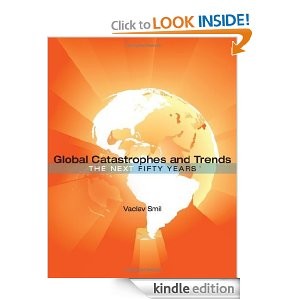
Vaclav Smil
![]() Very balanced and insightful thinking on the topic, September 3, 2010
Very balanced and insightful thinking on the topic, September 3, 2010
Contrary to what the title suggests, this is not about over-hyping any apocalyptic scenarios. To the contrary, Smil thinks through issues in an insightful and detached way. From the book, you develop critical thinking skills to vaccinate your mind against Media hype. You also develop a healthy skepticism towards any forecasts as they always miss the boat.
Smil classifies changes that could affect our civilization into two categories. First, the abrupt ones are unpredictable and potentially devastating. They include natural phenomena such as asteroids, volcanic eruptions, tsunamis, floods, earthquakes, and influenza pandemics. They also include man-caused wars, genocides, and terrorism. The second type of changes occur over half a century or more. Those include the energy transition away from fossil fuel, and the slow changes in balance of geopolitical powers.
Smil states we are notoriously bad at forecasting risks or anything else. He mentions numerous Peak Oil forecasts that were invariably wrong. Smil mentions how in the 1970s, we were concerned a next ice age was upon us. Geopolitic, economic, and demographic forecasts have been wrong too. The rapid economic ascent of China and rapid retreat of Japan since 1990 were unforeseen by everyone. The sudden break up of the USSR was also unexpected.
Smil states we are even bad at explaining what already happened. As an example, Diamond in his book Collapse: How Societies Choose to Fail or Succeed mentioned only deforestation as a cause of the devastation of the Easter Island community. But, he missed out on rats infestation, infectious diseases, and enslavement. We invariably miss out on tons of variables when explaining past events.
Smil geopolitical outlook is fascinating. The prospects for Europe and Japan are problematic because of declining populations due to aging societies. Also, Europe's identity will be challenged by the massive migration of Muslims who do not integrate themselves. This will stress Europe's already fragile fiscal condition. Japan's political system renders the country unable to adapt and resolve any upcoming national issue.
Russia, even more than Japan and Europe appears to face insurmountable demographic problems. It is the only modern society that is suffering an accelerated population decline due to both a drop in fertility rate and a rapidly decreasing lifespan. The latter is due to alcoholism among men. Russian officials have attempted to reduce the rate of alcoholism for decades in vain. This section contrasts with the embarrassingly bad After the Empire: The Breakdown of the American Order (European Perspectives: A Series in Social Thought and Cultural Criticism).
The Middle East prospect is dire due to poor governance, poor living standard, high illiteracy rates, outdated legal body, weak social infrastructure, repression of women, lack of any scientific achievement, and lack of water resources and arable land. Those societies also do not provide employment opportunities causing large young male population being diverted towards terrorist networks. For a good book on this topic, I recommend The Future of Freedom: Illiberal Democracy at Home and Abroad.
China is on the way up. It is the world's leading exporting manufacturer. By 2050, it should become the largest world economy. But, China faces challenges of its own. Its GDP per capita will remain a fraction of the US for several generations. Its one child policy has caused an uneven female/male ratio. This will cause a rapid aging of its population. This has implication for a country relying on an abundant and vibrant labor force. Its rapid economic growth is stressing the environment. China is losing scarce arable land to both industrialization and erosion impairing the country to feed itself. This will result in China relying more on food imports. But, given its huge population this is not a sustainable solution.
Within chapter 3, Smil outlook for the US is not encouraging. This is because it has gigantic Budget and Current Account Deficits. Those are the symptoms of the U.S. excessive spending, inadequate savings, and hollowing out of its manufacturing base. The U.S. is now even a net importer of hi tech equipment. Smil notices that the US economy's share of World GDP has already declined from 35% in 1945 to 20% currently. The US has lost its share of World GDP mainly to China.
However, within chapter 5. Smil's US outlook is more upbeat as he focuses on its strength and relative position. Smil notes that the US fiscal position is better than many European countries and Japan. Also, the US is still the champion of innovation and scientific discoveries. In 2004, 30% of the world's scientific papers were authored by the US vs only 6.5% for China. Adjusted for population size, the US is 20 times more productive than China. For another good book on this topic, I recommend The Post-American World.
Smil's section on climate change is very nuanced. He confirms that temperatures are rising and is probably due to anthropogenic CO2 emission. But, he states estimates of rise in CO2 concentration, temperature increase, and sea level rise are uncertain. But, prospective sea level rise should be moderate and due to warmer water expansion and very little from ice caps melting. Relying on several estimates from insurers and scientists, he states that the economic costs of adapting to climate changes are very manageable. This message contrasts with An Inconvenient Truth: The Planetary Emergency of Global Warming and What We Can Do About It apocalyptic tone.
Smil states that if we were a rational society we should be more concerned about changes in the water and nitrogen cycles than the rise in CO2 emission. He indicates that by 2050, nearly half of the world's population is projected to live in areas with scarce water resources. In 2003, half of the world's hospital beds were filled with patients with water-borne diseases (diarrhea, cholera, typhoid fever, etc…). Such waterborne diseases kill over 5 million people a year.
Smil mentions antibiotics resistance as a major environmental threat. Because of common overuse antibiotics resistance is now present in humans, domestic animals, and even wild animals that have never been exposed to those drugs. Some scientists think we may be near the point of returning to the pre-penicillin days, when we will have run out of antibiotics to defend against rapidly evolving bacteria. The same scientists deem such a situation catastrophic as it would result in additional millions of yearly deaths.
Smil conveys how we are paranoia about infrequent risks that we don't control such as terrorism vs being phlegmatic about extremely frequent and very high risk we do control such as car driving. He states “When strong emotions are involved, people tend to focus on the badness of the outcome rather than the probability [of the outcome].” This leads to bad social and individual reactions to risks. For another good book on this subject, I recommend Calculated Risks: How to Know When Numbers Deceive You.




